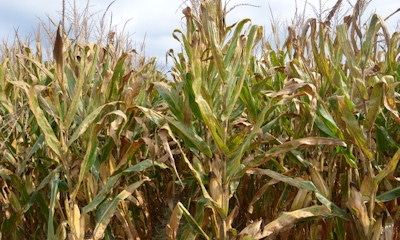
If you’re trying to get the most out of the money you spent on nitrogen, many agronomists and consultants will tell you to consider splitting up the application. And it’s not bad advice, depending upon exactly what they mean by splitting up the application. Is a split application some N at starter and the rest either before planting or sidedress? Or is it two or even three planned applications after the corn is up?
The theory is that the closer you apply the N to when the plant needs it, the lower the potential for loss of nitrogen. The lower the potential for loss of nitrogen, the more of what you applied that should be captured by plant roots and used by the plant.
 WILL THERE BE A DIFFERENCE? If there were any visual differences in the 2016 trial on Ken Simpson’s farm late in the season related to various N application timing methods, they didn’t show up when the combine went through the field.
WILL THERE BE A DIFFERENCE? If there were any visual differences in the 2016 trial on Ken Simpson’s farm late in the season related to various N application timing methods, they didn’t show up when the combine went through the field.
In practice it doesn’t always work out that way, notes Bob Nielsen, Purdue University Extension corn specialist. He works closely with Jim Camberato, Purdue Extension soil fertility specialist.
Related: 5 questions you shold ask before using starter fertilizer
“In a limited number of field trials, we did not see a benefit to a split application of applying two or three times after planting vs. just making a normal sidedressing trip after planting,” he says. “However, we will continue field-scale trials to evaluate these strategies.”
Nielsen points to one farmer trial in 2015 as a case study that typifies what they have seen when looking at split applications. This field-scale trial was done on the Ken Simpson farm near Morristown. It was actually their third year of testing on the farm, using a high-clearance applicator with a coulter-injection N toolbar. All the trials included 30 pounds of N per acre as row starter. In 2013 a single sidedress application of 180 pounds of N at V3, with three visible leaf collars, yielded the same as applying 90 pounds each at V3 and V9. In 2014 a single application of 180 pounds N at V7 yielded the same as split-as split applying 90 pounds each at V7 and V 13. The
In 2015 the trial consisted of three split-application timings: the V4, V14 and early silking. The application rates of actual N in pounds per acre at V4, V14 and R1, respectively, were: 200-0-0; 100-100-0; 100-50-50; 50-150-0; 50-75-75.
Corn was planted May 7 into typical central Indiana Brookston, Crosby soils. The field received just over 2 inches of rain between planting and the V4 sidedress N applications, about 11 inches between V4 and V 14 sidedress N applications and just under 5 inches between V14 and silking sidedress N applications.
Related: 3 questions you should answer about your soil fertility program
If you subscribe to the theory and believe putting more of the N on later helps, it should have helped last year if it would ever help, based on the excess rain received early in the season, Nielsen observes. Excess rain usually increases the potential for leaching, denitrification and overall higher N losses.
Data doesn’t lie. “There was no significant yield difference across any of the treatments,” Nielsen says.
Every single timing and rate combination yielded about 206 bushels per acre.

About the Author(s)
You May Also Like




